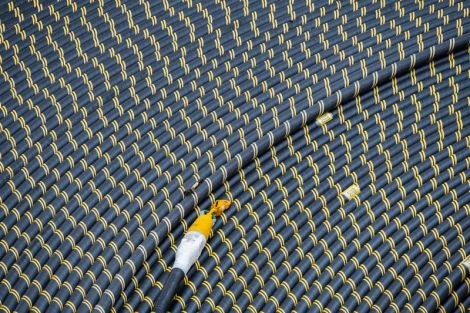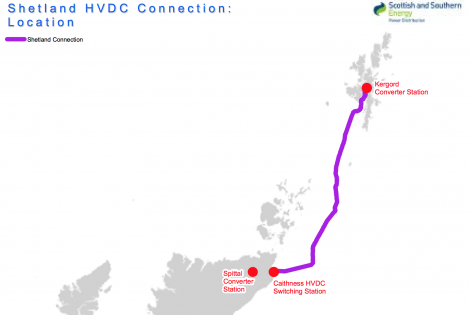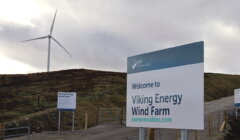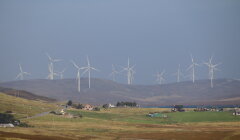Energy / Ofgem conditionally approves interconnector
SSE says the Viking wind farm will deliver substantial social-economic end environmental benefits
ENERGY regulator Ofgem says it is now in a position to approve the proposed 600MW interconnector between Shetland and the UK mainland, on the condition it is satisfied the Viking Energy wind farm is likely to go ahead.
The announcement has been welcomed by SSE Renewables, the company that owns the Viking Energy project. Campaign group Sustainable Shetland said they were deeply disappointed by the decision.
The regulator had previously been ‘minded to’ conditionally approve the HVDC link, but now it has confirmed it is giving the cable its conditional approval.
It said it was announcing the decision at this stage to “ensure the timely and efficient progress of works that are required in order to deliver the link and Viking Energy wind farm”.
“Delays to the works may lead to additional costs for GB consumers to ensure long-term security of supply on the Shetland Isles and risks non delivery of significant levels of low carbon generation which would contribute towards meeting the net zero target at the lowest cost to GB consumers,” the regulator added.
The conditional approval is despite Viking developer SSE confirming in June that it would invest £580 million into building the wind farm.
SSE chief executive Alistair Phillips-Davies said SSE Renewables is engaging with Ofgem to provide satisfactory evidence that by the end of 2020 Viking wind farm is likely to go ahead.
“Today’s decision marks a significant milestone in delivering a ‘whole system’ solution to meet Shetland’s future needs, as well supporting the transition to net zero emissions, and shows again that we are putting our money where our mouth is on driving the green recovery,” he said.
“It has been a long journey, but with a combined investment in excess of £1bn, the construction of the subsea transmission link, all associated onshore infrastructure and the Viking Energy wind farm will deliver substantial socio-economic and environmental benefits to Shetland’s, Scotland’s and the UK’s economy, supporting hundreds of skilled jobs in the process.”
Become a member of Shetland News
The cable, proposed by Scottish Hydro Electric Transmission, would run between Caithness and Weisdale Voe before heading to a converter station at Upper Kergord.
The transmission link is expected to cost £632 million.
Ofgem said that subject to all of the conditions for approval being satisfied, there is “clear technical need for the reinforcement” and that the “link is likely to represent an economic and efficient outcome (in terms of long-term value for money) for existing and future GB consumers”.
“This is because the link, once operational, will ensure long term security of supply on the Shetland Isles, whilst also allowing significant levels of low carbon generation to connect to the electricity network that can contribute towards meeting the Net Zero target at the lowest cost to GB consumers,” it added.
Ofgem said that if it is satisfied that Viking Energy is likely to go ahead, “we will confirm and publish that, putting into effect our final approval of the final needs case for the Shetland transmission project”.
It added that plans for a gas-fired power station in Shetland, “while helping ensure long term security of supply, would not allow significant levels of new renewable generation to connect on Shetland”.
The cable is a pivotal part of Shetland’s possible future energy jigsaw once Lerwick Power Station comes to the end of its lifespan by 2026.
Not only would it enable the 103-turbine Viking Energy wind farm to go ahead, but it would allow other proposed renewable wind developments to go ahead.
These include the consented Peel Energy wind farms in Yell and the outskirts of Lerwick.
Sustainable Shetland chairman Hay said it was “very disappointing news for the future of Shetland and its security of energy supply”.
“When the latest consultation was announced we felt, in the light of comments by Ofgem chief Jonathan Brearley, that the consultation was a sham,” he added.
“The announcement today confirms that view. Investigations have revealed that an HVDC cable research unit had been set up in 2017 and was managed by SSE.
“The funding for the unit comes from Ofgem and a major part of the units work has been research into the cable to Shetland.
“Therefore, since 2017, the cable to Shetland was pretty much a done deal. SSE‘s enthusiasm for the Viking wind farm may yet come back to bite them as deep peat moorland and extreme weather conditions, especially during winter, may well make construction of the Viking wind farm a daunting prospect with many delays likely.
“We remain of the opinion that large scale wind farms such as Viking Energy are totally inappropriate for Shetland. Those responsible for Shetland being exploited by a ruthless wind farm developer should hang their heads in shame and disgrace.”
In March Ofgem said it was minded to conditionally approve the subsea transmission link – which will allow large wind farms to export energy as well as enable power to be imported north – before launching a consultation.
It received over 180 responses, with Ofgem conceding that “most of the responses to the consultation did not agree with our minded-to position”.
Further detail on the responses will be published with Ofgem’s full decision at the end of July.
Become a member of Shetland News
Shetland News is asking its readers to consider paying for membership to get additional perks:
- Removal of third-party ads;
- Bookmark posts to read later;
- Exclusive curated weekly newsletter;
- Hide membership messages;
- Comments open for discussion.
If you appreciate what we do and feel strongly about impartial local journalism, then please become a member of Shetland News by either making a single payment, or setting up a monthly, quarterly or yearly subscription.












































































